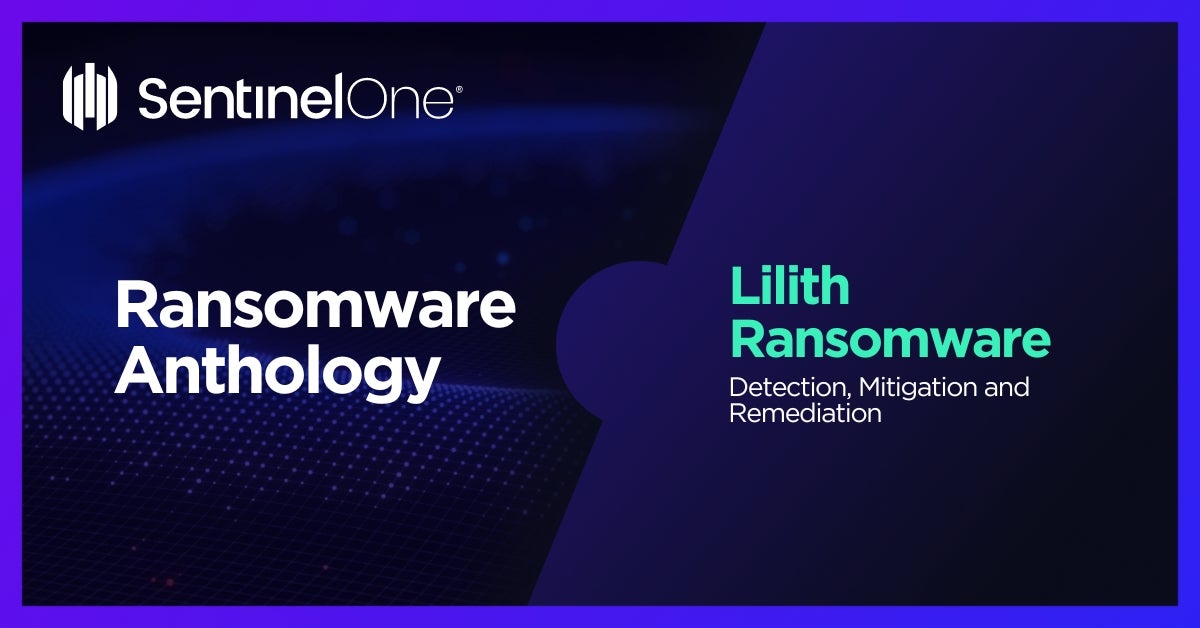Lilith Ransomware: In-Depth Analysis, Detection, and Mitigation
What is Lilith Ransomware?
Lilith (aka LilithCrypt) ransomware is a low-sophistication ransomware family that emerged in July of 2022. Lilith engages in multi-pronged extortion, meaning should their victims fail to comply with the attacker’s demands, they are listed on the Lilith victim blog alongside their stolen data. There are both Windows and Linux variants of Lilith ransomware.

What Does Lilith Ransomware Target?
Lilith ransomware is known to target small to medium sized businesses (SMBs). They have also been known to focus on those in the construction and manufacturing industries.
How Does Lilith Ransomware Work?
Lilith ransomware targets its victims through trojanized downloads as well as phishing emails.
Lilith Ransomware Technical Details
Random keys are generated via the CryptGenRandom function. Based on current observations, Lilith victims are given three days to comply with the attackers’ demands. Lilith operators appear to only communicate with the victims via TOX chat.
Once executed, Lilith payloads will attempt to discover problematic processes that may inhibit the encryption process and terminate them. Lilith payloads have the ability to achieve persistence by installing a persistent system service.
How to Detect Lilith Ransomware
The SentinelOne Singularity XDR Platform detects and prevents malicious behaviors and artifacts associated with Lilith ransomware.
If you do not have SentinelOne deployed, here are a few ways you can identify LilithLilth ransomware in your network:
Security Tools
Use anti-malware software or other security tools capable of detecting and blocking known ransomware variants. These tools may use signatures, heuristics, or machine learning algorithms, to identify and block suspicious files or activities.
Network Traffic
Monitor network traffic and look for indicators of compromise, such as unusual network traffic patterns or communication with known command-and-control servers.
Security Audits
Conduct regular security audits and assessments to identify network and system vulnerabilities and ensure that all security controls are in place and functioning properly.
Education & Training
Educate and train employees on cybersecurity best practices, including identifying and reporting suspicious emails or other threats.
Backup & Recovery Plan
Implement a robust backup and recovery plan to ensure that the organization has a copy of its data and can restore it in case of an attack.
How to Mitigate Lilith Ransomware
SentinelOne Singularity XDR Platform prevents Lilith ransomware infections. In case of an infection, the SentinelOne Singularity XDR Platform detects and prevents malicious behaviors and artifacts associated with Lilith ransomware.
SentinelOne customers are protected from Liith ransomware without any need to update or take action. In cases where the policy was set to Detect Only and a device became infected, remove the infection by using SentinelOne’s unique rollback capability. As the accompanying video shows, the rollback will revert any malicious impact on the device and restore encrypted files to their original state.
In case you do not have SentinelOne deployed, there are several steps that organizations can take to mitigate the risk of Lilith ransomware attacks:
Educate employees
Employees should be educated on the risks of ransomware, and how to identify and avoid phishing emails, malicious attachments, and other threats. They should be encouraged to report suspicious emails or attachments, and to avoid opening them, or clicking on links or buttons in them.
Implement strong passwords
Organizations should implement strong, unique passwords for all user accounts, and should regularly update and rotate these passwords. Passwords should be at least 8 characters long and should include a combination of uppercase and lowercase letters, numbers, and special characters.
Enable multi-factor authentication
Organizations should enable multi-factor authentication (MFA) for all user accounts, to provide an additional layer of security. This can be done through the use of mobile apps, such as Google Authenticator or Microsoft Authenticator, or the use of physical tokens or smart cards.
Update and patch systems
Organizations should regularly update and patch their systems, to fix any known vulnerabilities, and to prevent attackers from exploiting them. This includes updating the operating system, applications, and firmware on all devices, as well as disabling any unnecessary or unused services or protocols.
Implement backup and disaster recovery
Organizations should implement regular backup and disaster recovery (BDR) processes, to ensure that they can recover from ransomware attacks or other disasters. This includes creating regular backups of all data and systems and storing these backups in a secure, offsite location. The backups should be tested regularly to ensure that they are working and that they can be restored quickly and easily.